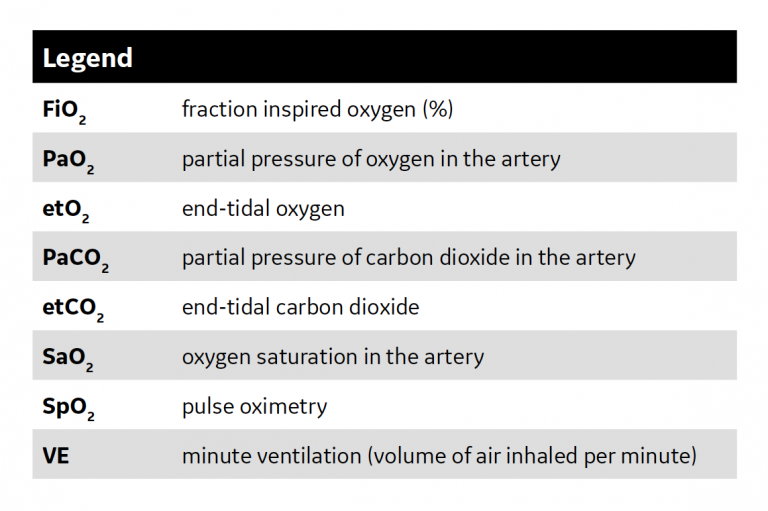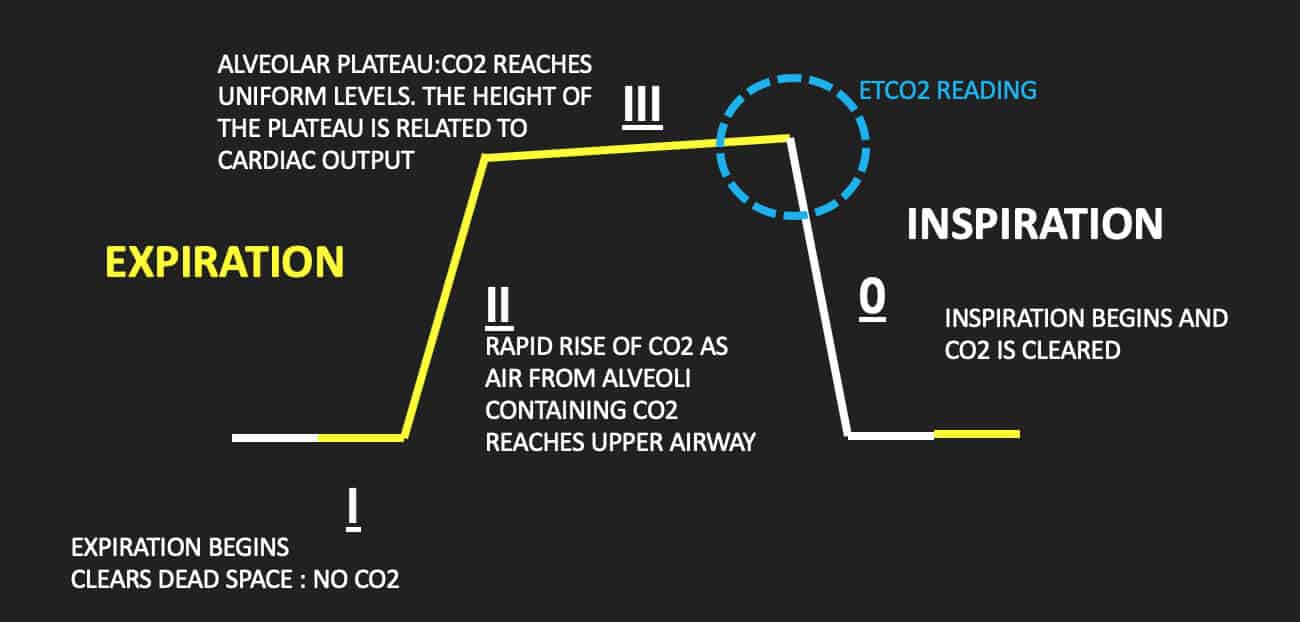end tidal co2 range high
Cardiac output and end-tidal carbon dioxide. A low end-tidal CO2 may indicate poor perfusion hypovolemia or sepsis.

End Tidal Capnography Can Be Useful For Detecting Diabetic Ketoacidosis Monitoring Copd Acep Now
Graphically this difference in ROSC vs non-ROSC PetCO2 for both groups appeared to be even greater at ten minutes.

. Abnormal end-tidal carbon dioxide levels on emergency department arrival in adult and pediatric intubated patients. Cardiac Oscillations dose-dependent fashion with increasing Anestheticdepth. Chest compression provider tiring end-tidal CO2 value diminishes over time.
The higher the ETCO2 measured during compressions the better the perfusion being supplied by CPR. Persistently low end-tidal CO2 check quality of compressions check ventilation volume if persistent may be a. End tidal CO 2 monitoring is represented as a number and a graph on a monitor.
In the ED we typically think of a EtCO2 as a marker of perfusion and ventilation. 78 Nitrogen 21 Oxygen 1 CO2 and other gases Exhaled gases. MmHg Relate to the air we breath.
An ETCO2 below 10 mmHg is associated with poor outcome. Capnometry is the measurement of carbon dioxide CO2 in exhaled gas ETCO2. NaHC03 will increase EtCO2 because it splits into CO2 and H20 So if rises after NaHCO3 do not misinterpret as ROSC Vasopressors will decrease ETCO2 they cause high afterload increasing BP and myocardial blood flow but a decrease in cardiac output.
High quality CPR consistent waveform and end-tidal CO2 20 kPa. Throughout the resuscitation end-tidal CO 2 was consistently in. The end-tidal carbon dioxide tension PetCO2 measured after a single large tidal-volume breath 15 mlkg body weight was compared to simultaneous measurements of PaCO2 in 6 dogs with normal lungs who were receiving high-frequency jet ventilation HFJV.
The waveform is called capnograph and shows how much CO 2 is present at each phase of the respiratory cycle. Capnograph is an indispensable tool for monitoring metabolic and respiratory function. ETCO2 is one valuable tool we have to tell us that good quality compressions are being delivered.
Values including 37 39 95 CI 29 49 with low ETCO2 levels and. In infants and children breathing spontaneously the PETCO 2 values range from 36-40 mmHg9 Normally. What should end-tidal CO2 be during CPR.
Normal range is 35-45mmHg and roughly correlates with the partial pressure of CO2 in arterial blood remember that PaCO2 is usually slightly higher than. J Intensive Care Med. N Engl J Med 1988318607-11.
High CO2 causes high HRBP and injected mucous membranes In this case the ETCO2 may be underestimating the true alveolar and arterial CO2. The amount of CO2 at the end of exhalation or end-tidal CO2 ETCO2 is normally 35-45 mm HG. End Tidal CO 2 6 Can also be measured and monitored in spontaneously.
A low end-tidal CO2 may indicate poor perfusion hypovolemia or sepsis. Interquartile range IQR 15 48 years. However EtCO2 is an extremely powerful surrogate for endotracheal tube ETT P osition CPR Q uality R eturn of.
In mmHg the PetCO2 values for those with and without ROSC after five minutes of CPR was. 428 153 mmHg versus 323 141 mmHg. On the other hand a high CO2 reading may indicate airway narrowing.
Respiratory Function ETCO 2 pitfalls and interpretation End Tidal CO 2 ETCO2 monitors measure the CO2 partial pressure using. Total pressure of a gas is the sum of the partial pressures of the gas Expired CO2 measured PetCO2 mmHg in waveform Percentage Normal Levels PaO2 85-100mmHg PaCO2 35-45mmHg Percentage vs. According to the book by Hockenberry and Wilson 2015 p 1140 normal values of ETCO2 are 30-43 mmHg which is slightly lower than arterial PaCO2 35-45mmHg.
Consequently a strategy of high-frequency low-tidal volume breaths will tend to achieve less CO2 clearance for any specific total minute ventilation. End-Tidal CO2 in Cardiopulmonary Resuscitation EtCO2 in CPR. The goal should be to maintain ETCO2 no lower than 10-20 mmHg.
Although the normal range for CO2 should be between 35-45mmHg CO2 monitoring gives healthcare providers a lot more insight into what is going on with a patients condition. Sudden increase in end-tidal CO2 return of spontaneous circulation. ETCO2 emergency department monitoring and critical.
There was an excellent linear correlation b. This gives us a means of estimating ventilation and how well the lungs are removing CO2 from the body. The number is called capnometry which is the partial pressure of CO 2 detected at the end of exhalation ranging between 35 - 45 mm Hg or 40 57 kPa.
End-tidal carbon dioxide concentration during cardiopulmonary resuscitation. In this study the aim was to review the applications of end-tidal carbon dioxide ETCO2 monitoring in emergency department multiple databases were comprehensively searched with combination of following keywords. 11172009 4 Measuring End Tidal CO2 Daltons Law.
End-tidal CO2 EtCO2 monitoring is a measure of metabolism perfusion and ventilation. The height of the capnography waveform accompanies this number on the monitor as well as the. Esophageal intubations were identified in four cases and those cases were excluded from further analysis.
The high pressure alarm often alerts the nurse to a problem. More Than Just a Number. 39 Treveno RP Bisera J Weil MH Rackow EC Grundler WG.
Changes in end. 423 20 mmHg versus 34 255 mmHg. For most patients the gap between etCO2 and PaCO2 will be 5-10 mm which will leave them at the higher end of this range eg a pH of 74.

Average Etco2 Kpa During Cpr In Patients With Or Without Rosc Download Scientific Diagram

Waveform Capnography In The Intubated Patient Emcrit Project

Waveform Capnography In The Intubated Patient Emcrit Project
End Tidal Co2 Monitoring In The Pre Hospital Environment More Than Just Endotracheal Tube Placement Confirmation Journal Of Paramedic Practice
Riding The Wave Of Capnography Understanding Etco2 Vetbloom Blog
Riding The Wave Of Capnography Understanding Etco2 Vetbloom Blog

Exhaled Carbon Monoxide End Tidal Co2 And Peripheral Oxygen Saturation Download Table

The Impact Of Ventilation Rate On End Tidal Carbon Dioxide Level During Manual Cardiopulmonary Resuscitation Resuscitation

End Tidal Oxygen Measurement White Paper Clinical View

End Tidal C02 Worth The Investment
Emdocs Net Emergency Medicine Educationcapnography In The Ed Emdocs Net Emergency Medicine Education

5 Medical Conditions Where Capnography Can Affect Bls Care

Exhaled Carbon Monoxide End Tidal Co2 And Peripheral Oxygen Saturation Download Table

Etco2 Valuable Vital Sign To Assess Perfusion The Airway Jedi

Capnography Provides Bigger Physiological Picture To Maximize Patient Care Jems Ems Emergency Medical Services Training Paramedic Emt News

Waveform Capnography In The Intubated Patient Emcrit Project

